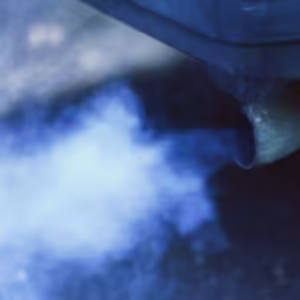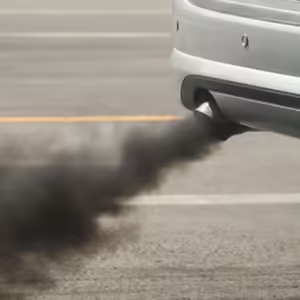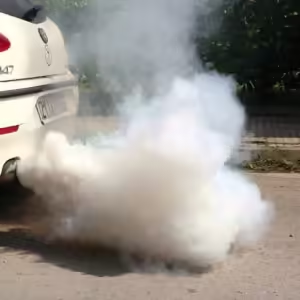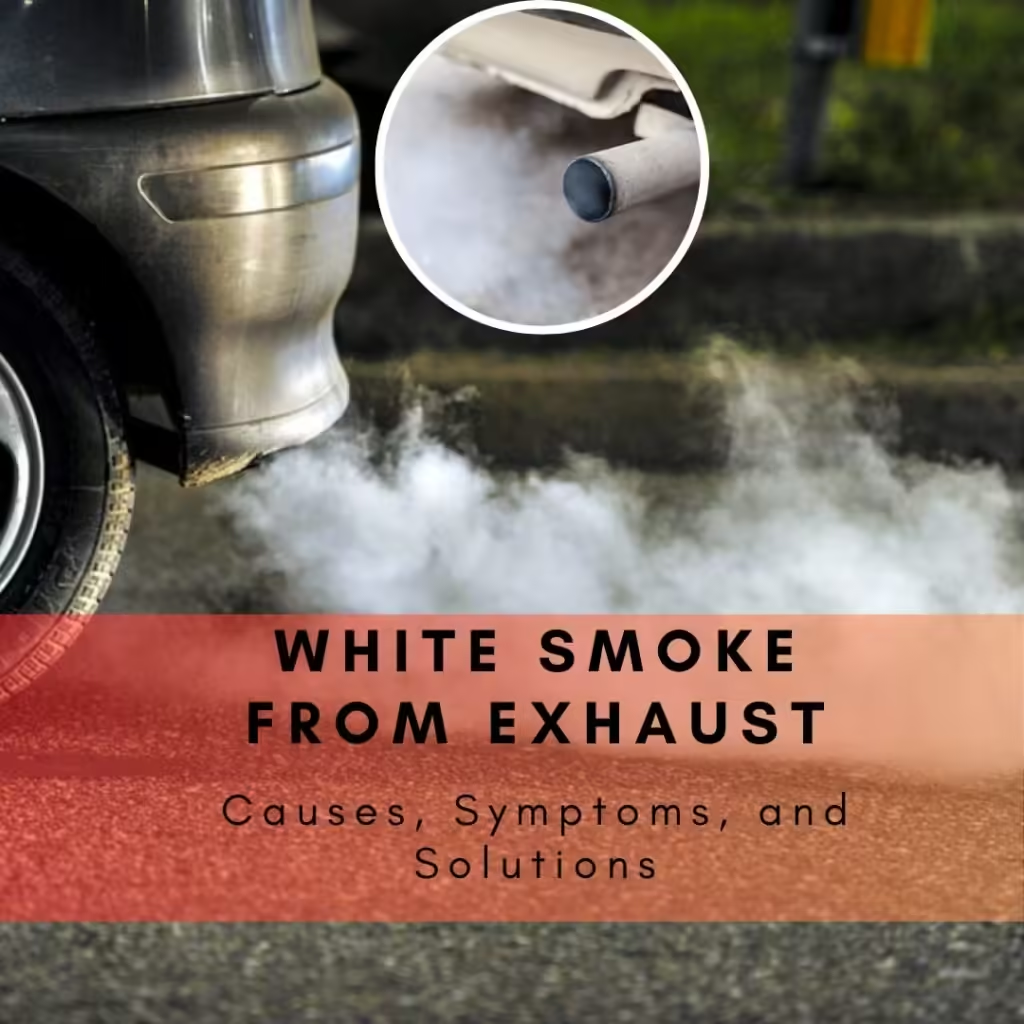Is your car suffering from a smoky exhaust? This troubleshooting guide will tell you the causes and what you need to do to fix it!
Exhaust smoke can be an important indicator of your vehicle’s health. While it’s common to see some smoke on cold mornings, certain colors or volumes of smoke can signal issues. Car exhaust smoke can appear in different colors and thicknesses, each serving as an indicator of your engine’s health and what’s happening under the hood. The exhaust can be black, blue, gray, or white. White smoke, in particular, often raises concerns for drivers because it may indicate various issues within the vehicle’s engine. These colors are often not a cause for concern, understanding their meanings can assist in diagnosing serious mechanical issues. But don’t worry—our guide to car exhaust smoke is here to help you navigate these signs!
Understanding Exhaust Smoke
Exhaust smoke can serve as a crucial indicator of your vehicle’s overall health and performance. While it’s normal to observe some smoke on cold mornings, when the engine is warming up, the color and volume of the smoke can provide valuable insights into potential issues. Drivers should pay close attention to the characteristics of the exhaust smoke, as different colors may signify different problems. Exhaust smoke generally comes in three colors: black, blue, and white. Each color can suggest different problems:
Blue Smoke

Blue smoke is a clear sign that oil is burning in the engine, indicating an oil leak. This often results from reduced lubrication of engine parts, leading to worn seals that may need replacement to prevent further leakage. As oil seeps past these seals into the cylinders, it mixes with fuel and produces significant blue smoke, particularly in older or high-mileage cars. Even a small amount of oil entering the cylinders can cause excessive blue exhaust smoke.
Blue smoke during start-up can suggest worn piston seals or damaged valve guides, potentially accompanied by a rattling noise. Additionally, an external oil leak may drip onto hot engine parts, creating the appearance of blue smoke. Other causes include
- Piston wear
- Worn valve seals
- A faulty PCV valve
- Worn piston rings
- An intake manifold gasket leak
- Worn oil seals
- Possible head gasket failure.
Black Smoke

Black exhaust smoke indicates that the engine is burning too much fuel. Start by checking your air filter and intake components, such as sensors, fuel injectors, and the fuel pressure regulator. Another possible cause could be a clogged fuel return line. While black smoke is often one of the easier issues to diagnose and fix, excessive fuel consumption will negatively impact your fuel economy. Don’t overlook this problem to save money; delaying repairs can lead to more expensive consequences. Other causes include
- Clogged Air Filter
- Faulty Fuel Injectors
- Bad Fuel Pressure Regulator
- Malfunctioning Mass Air Flow (MAF) Sensor
- Dirty or Clogged Intake Manifold
- Excessive Fuel Return Line Pressure
- Worn Engine Components
- Engine Tuning Issues
- Cold Engine Start
White Smoke

Thin white smoke that dissipates quickly is not a cause for concern; it often results from normal condensation buildup in the exhaust system. This vapor-like smoke is usually harmless and can occur during cold starts or in humid conditions. However, if you notice thick clouds of white smoke, this indicates a serious issue that requires immediate attention. Such smoke often signifies that the engine is burning coolant, which could be due to critical problems such as a blown head gasket, a damaged cylinder head, or a cracked engine block. These repairs can be quite expensive and should not be ignored. Addressing this issue promptly is crucial, as even a small coolant leak can lead to overheating, putting your engine at significant risk of damage. Additionally, a coolant leak may mix with the engine oil, resulting in severe complications that could lead to costly repairs down the line. If you encounter thick white smoke, it’s essential to consult a mechanic as soon as possible to prevent further damage to your vehicle. Other reasons may include:
- Condensation
- Burning Coolant
- Blown Head Gasket: A common issue that allows coolant to leak into the cylinders.
- Cracked Engine Block: Damage to the engine block that lets coolant seep into the combustion area.
- Damaged Cylinder Head: A faulty or warped cylinder head can also permit coolant to mix with the fuel.
- Fuel Quality Issues
- Injector Problems
- Oil Leaks
- Exhaust Gas Recirculation (EGR) System Issues
What Causes White Smoke?
White smoke from an exhaust pipe can have several causes, ranging from harmless to serious. Here are some common reasons:
Coolant Leak
One of the primary causes of persistent white smoke is a coolant leak. When coolant enters the engine’s combustion chamber, it burns off, producing thick white smoke that is often accompanied by a sweet, distinctive odor. This issue typically arises from a blown head gasket, a damaged cylinder head, or even a cracked engine block.
Condensation
Not all white smoke is a cause for concern. In fact, condensation buildup is quite common during cold starts, particularly in cooler weather. As the engine warms up, the water vapor that forms in the exhaust system escapes, resulting in a brief burst of white smoke that quickly dissipates. This type of smoke is harmless and should not raise any alarms.
Fuel Issues
White smoke can also indicate problems with the fuel mixture. If the air-fuel ratio is too lean, or if the fuel injectors are malfunctioning, it can lead to a smoky exhaust. In such cases, drivers might also experience symptoms like poor engine performance or rough idling. Addressing fuel system issues promptly can help restore normal function and prevent further complications.
Symptoms of a Problem
When white smoke is linked to a problem, other signs can often accompany it:
- Engine Overheating: If a coolant leak is the cause, your engine temperature may rise as it loses coolant.
- Loss of Performance: Problems like fuel mixture issues often impact the vehicle’s overall performance.
- Check Engine Light: This light may indicate an issue with the fuel system, engine, or cooling system.
- Fluid Leaks: Coolant or oil leaks can sometimes be spotted under the car if they are causing the smoke.
Keeping an eye on these symptoms can help determine if the white smoke is serious.
Potential Consequences
Ignoring white smoke can lead to more severe damage:
- Engine Damage: Leaks in the head gasket, cylinder head, or engine block can lead to overheating and engine failure if left untreated.
- Costly Repairs: Serious issues that cause white smoke, such as a blown head gasket, can be expensive to repair, potentially leading to thousands of dollars in costs.
- Reduced Safety: If the engine is damaged, it could fail unexpectedly, increasing the risk of accidents.
Prompt attention to persistent white smoke can help avoid costly repairs and keep your vehicle safe to drive.
Diagnosis and Troubleshooting
Diagnosing white smoke often involves examining possible causes step-by-step:
- Check Coolant Levels: Low coolant can indicate a leak. Look for other signs like overheating or white residue in the engine.
- Inspect Engine Oil: A milky appearance in the oil may indicate a coolant leak into the engine.
- Check for Fluid Leaks: Look under the car for leaks and inspect the radiator, hoses, and reservoir.
- Consult a Mechanic: If you’re unsure, it’s best to get a professional diagnosis to prevent misinterpretation.
A qualified mechanic can run additional tests, like compression tests, to find internal leaks.
Preventive Measures
While some causes of white smoke can’t be prevented, regular maintenance can reduce your risk:
- Regular Inspections: Inspect coolant, oil levels, and hoses during routine checks.
- Engine Maintenance: Have your engine inspected annually to detect early signs of wear or damage.
- Use High-Quality Fluids: Good-quality oil and coolant can prevent buildup and clogging, reducing wear on engine components.
- Fix Leaks Early: Addressing leaks as soon as they arise prevents further damage to your engine.
Consistent care and timely fixes can help avoid serious problems linked to white smoke.
FAQs
1. What does it mean if white smoke appears only on startup?
It’s usually just condensation, especially on cold days. This smoke should clear up as the engine warms up.
2. How can I tell if white smoke is from a coolant leak?
Look for other symptoms like overheating, a sweet smell, and low coolant levels. A mechanic can confirm with tests.
3. Is white smoke more common in older cars?
Yes, as older vehicles are more prone to wear that can cause leaks and smoke.
4. Will driving with white smoke harm my engine?
If it’s due to a serious issue like a coolant leak, it can cause engine damage and should be addressed immediately.
5. Can low fuel quality cause white smoke?
It’s uncommon but possible if the fuel mixture is improper. This would also usually result in rough performance.
6. How expensive is it to repair a coolant leak causing white smoke?
Repair costs vary; a simple hose fix is inexpensive, but replacing a head gasket can be costly.
7. Do diesel cars experience white smoke too?
Yes, diesel engines can also produce white smoke from issues like coolant leaks or fuel mix problems.
8. How can I tell if my exhaust smoke is white or blue?
White smoke is generally thicker and may have a sweet smell if from coolant; blue smoke is thinner and has an oily scent.
9. Does white smoke always mean an engine problem?
No, sometimes it’s just condensation, especially in colder weather. Persistent smoke, however, could indicate a problem.
10. Can I ignore white smoke if my car runs fine?
It’s best to investigate, as hidden problems could cause costly damage if left unchecked.
Thank you for reading, for more interesting articles visit our homepage.



